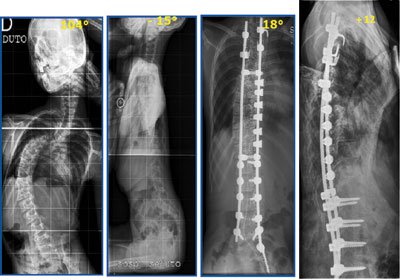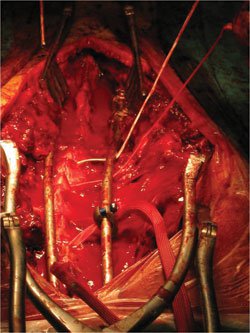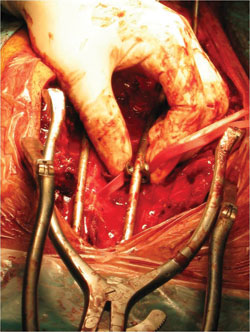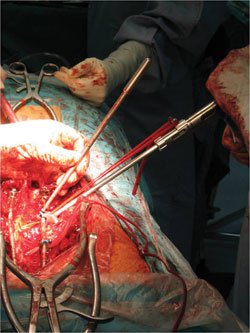Hybrid construct provides adequate correction of deformity in patients with neurological scoliosis
Italian orthopaedists reported a low rate of complications when treating patients with high-grade neurological scoliosis using a hybrid construct that combined lumbar pedicle screws, Universal Clamps (Zimmer) and thoracic hooks.
“The hybrid construct … appears safe and effective in the treatment of patients affected by high-grade scoliosis, providing a good correction of deformity and reducing operative time, radiation exposure and blood loss with respect to all-screws constructs,” Guido La Rosa, MD, Chief of Orthopedic Unit, Research Institute Pediatric Hospital “Bambino Gesu,” Rome, Italy, told Orthopaedics Today Europe in an interview prior to the presentation of the study at the EFORT Congress 2010.
Study design
A prospective series of 15 neurological scoliosis patients were treated by La Rosa and colleagues between 2002 and 2008 with the hybrid construct. Patients ranged in age from 10 to 17 years, and etiologies were as follows: cerebral palsy in 12 patients, Friedreich’s ataxia in two and Aicardi Syndrome in one. All patients had a preoperative Cobb angle greater than 100°, according to the study abstract.
 Neurological scoliosis with a marked hypokyphosis treated by means of bilateral all level lumbar screws plus all level Universal Clamps thoracic instrumentation. Excellent coronal correction with an optimal sagittal contouring. Images: La Rosa G |
All patients were treated by posterior access using the hybrid construct to stabilize each affected level. A secondary posterior access was used in three patients to strengthen the effect of the Universal Clamps, adding a concave costotomy. Skull traction by sling and pelvic countertraction to control obliquity were performed in all cases. Pelvic instrumentation provided iliosacral screw fixation, and two concave rods and one convex were used in all patients, the investigators wrote in their abstract.
 The tape is passed under the lamina and under the concave corrective rod. |
 Each titanium clamp is assembled to the rod. |  The tape is tensioned by means of tightening-gun and tightening of the blocker at the end of correction. |
Deformity correction
 Final assembly of the hybrid construct is shown. |
The average percentage of correction was 70% (32°±7°), with an average loss of correction of 7° occurring during the mean 36-month follow-up period (range, 12–84 months). Mean operative time was 4 hours with a mean blood loss of 1800 mL. On average, six transpedicular screws (range, 4–11), seven Universal Clamps (range, 5–9) and five thoracic hooks (range, 4–6) were used in the hybrid constructs, according to the abstract.
“The amount of coronal correction is excellent and the control of the sagittal profile seems better than with all-screws assembly,” La Rosa said. “In conclusion, the overall incidence of complications has been quite similar to other corrective procedures — in particular, no neural complications have been recorded.”
- Reference:
La Rosa G, Giglio G, Oggiano L. Treatment of neurological scoliosis of more than 1008 by using a hybrid contstruct (pedicle screws plus universal clamps). Paper #F484. To be presented at the EFORT Congress 2010. June 2-5, 2010. Madrid.
The treatment of patients with high-grade neurological scoliosis continues to remain a challenge. These authors report excellent coronal correction and control of sagittal profile using a hybrid construct of lumbar pedicle screws, clamps and thoracic hooks. While they report “safe and effective treatment with respect to an all-pedicle screw constructs,” their all-pedicle screw construct data were not included in the material for review.
These were large curves noted to be greater than 100· in the study abstract with an average percentage correction of 70%. A posterior access was used in all but three patients where concave osteotomy was used. Skull traction and pelvic countertraction was used in all cases to correct for pelvic obliquity (an extremely effective method used by this reviewer with these type cases). The Universal clamps represent fixation very similar to sublaminar wires which remain a staple for treatment for this deformity.
The success of this prospective study in the use of “a hybrid construct” to manage this group of cases is to be commended. Not included in the abstract was the management of perioperative nutrition, wound problems, shunts and infections not uncommonly found in this population. The inclusion of these strategies will be important for the publication of this series. While the numbers are small, their early results are stellar.
– Alvin H. Crawford, MD
Professor of Pediatric Orthopedic Surgery
Cincinnati Children’s Hospital Medical Center
